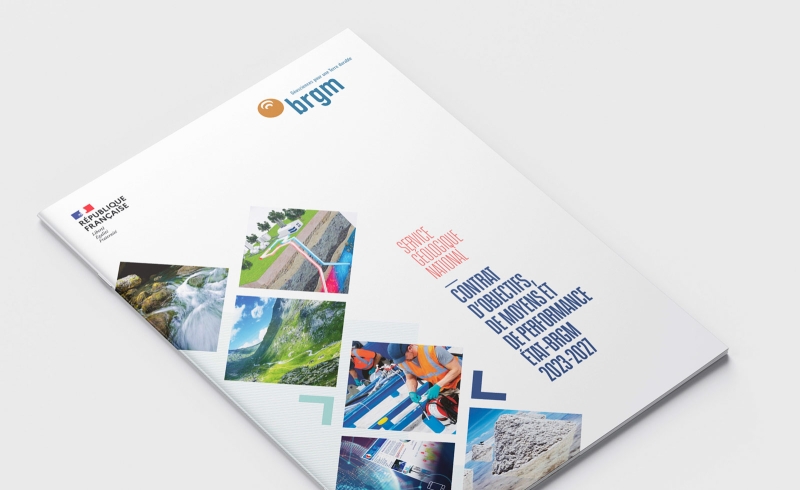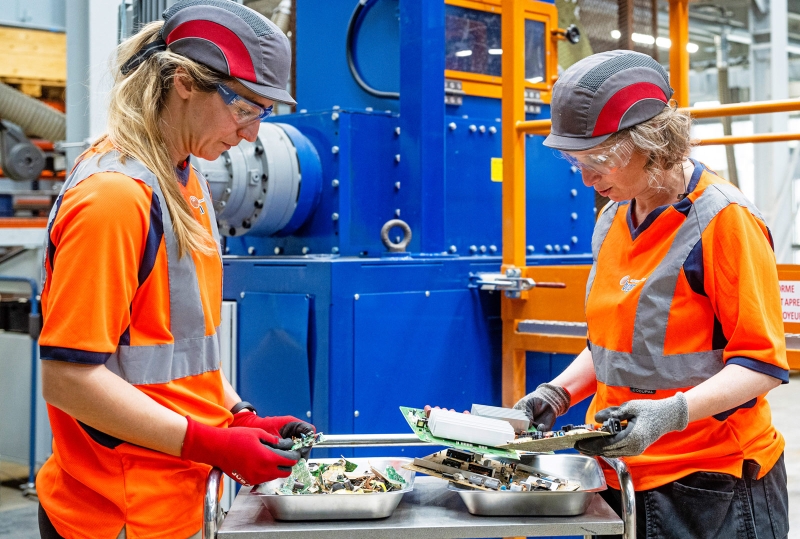Cover of the State-BRGM Objectives, Resources and Performance Contract for 2023-2027. © BRGM
Objectives contract
Objectives and strategy: a new contract with the State, including a budget
BRGM’s role is embodied in applied research and expertise on the ground and the subsurface. As a public body, BRGM is linked to the State via its supervisory bodies through a five-year contract that establishes its trajectory and objectives, with quantifiable and measurable indicators. The new Objectives, Resources and Performance Contract was adopted by the Board of Directors in December 2022 and signed in early 2023 by the four supervising ministers: Sylvie Retailleau, Minister for Higher Education and Research; Christophe Béchu, Minister for the Ecological Transition and Territorial Cohesion; Bruno Le Maire, Minister for the Economy, Finance and Industrial and Digital Sovereignty and Agnès Pannier-Runacher, Minister for the Energy Transition.
A first for BRGM
This is a real novelty for BRGM, as the traditional five-year dialogue framework for BRGM and its supervising ministries has for the first time been provided with a State budget to achieve specific objectives.
This new framework was recently set up by the Ministry of Higher Education and Research under the Research Programming Act, which enables research bodies to adopt strategies with multi-year budgets.
Note that the drafting phase was an opportunity for BRGM to discuss its objectives with its supervising ministries, but also with its main partners and on the basis of broad in-house staff consultations.
The COMP was drawn up on the basis of the evaluation and recommendations of the High Council for the Evaluation of Research and Higher Education (HCERES). It emphasises “the leading role of BRGM in ground and subsurface issues, an establishment “of strategic interest”, “with no national equivalent”. It acknowledges “the scale of the work undertaken” between 2017 and 2021 and notes a “significant improvement in its internal organisation”. “Quality of research and expertise” is identified as one of the organisation’s strengths.
The report also highlights that “BRGM is very well positioned in the fields of mining and post-mining, critical materials, the energy transition and the circular economy, which are all extremely important matters in the current context”. In particular, the committee recommends that BRGM should strengthen its national and European leadership and develop a structured regional partnership approach to support public policies.
The 2023-27 COMP firstly reaffirms the three main roles entrusted to BRGM: scientific research, scientific and technical expertise in support of public policies and economic players, and support for innovation aimed at companies. This approach led to the identification of 13 objectives and 31 activities, structured around 3 goals.
Goal 1: Implement an ambitious scientific policy to acquire new knowledge so as to respond more fully to challenges in society
This goal arises from BRGM’s policy to stimulate and consolidate its scientific activities around its six scientific strategic objectives and strengthen its role in the research and innovation ecosystem in order to make a decisive contribution to mitigating the effects of and adapting to climate change and to the crucial role of the subsurface in energy and ecological transitions.
It covers the activities relating to the institution’s scientific policy, its subdivision into scientific programmes, its partnership strategy and its digital strategy. It also sets out an objective linked to the medium-term management of scientific skills.
Goal 2: Develop BRGM’s impact on society through its science, innovation and expertise
The aim is to strengthen BRGM’s impact on society by using its skills and knowledge to provide expertise with high scientific added value that is relevant and accessible to society as a whole: from state bodies and local authorities to civil society and citizens.
Goal 2 sets out activities aimed at public bodies and local authorities, economic players, beneficiaries of initial and ongoing training (initial training strategy, intensification of ongoing training) and civil society (open science policy, scientific outreach policy).
Goal 3: Manage the institution in a modernised and simplified way to strengthen its economic model and resources for the purposes of sustainable development
This last goal reflects the desire to modernise and simplify processes and tools to improve efficiency in operating and managing the institution. Activities will include optimising financial management and reducing the institution’s carbon footprint.
Examining so-called “rich” computer motherboards (gold content approx. 100g/t) before placing them in the shredding machine visible in the background. Shredding circuit boards is the first phase of a gold and palladium recovery process. © BRGM - D. Depoorter







